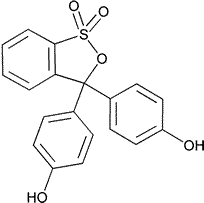Add the following:
»Phenolsulfonphthalein contains not less than 98.0percent and not more than 102.0percent of C19H14O5S,calculated on the dried basis.
Identification—
A:
Transfer 5mg of Phenolsulfonphthalein to a 100-mLvolumetric flask,dissolve in and dilute with sodium carbonate solution (1in 100)to volume,and mix.Dilute 5.0mLof the solution so obtained to 100.0mLwith sodium carbonate solution (1in 100).Examined between 400and 630nm,the solution exhibits an absorption maximum at 558nm.The specific absorbance at the maximum is between 1900and 2100.
B:
Dissolve about 10mg of Phenolsulfonphthalein in 2mLof 1Nsodium hydroxide,and add 8mLof water.To 5mLof the solution so obtained add 1mLof 0.1Npotassium bromide–bromate and 1mLof diluted hydrochloric acid,shake,and allow to stand for 15minutes.Render the solution alkaline with 1Nsodium hydroxide:an intense violet-blue color is produced.
Visual transition interval—
Dissolve 1.0g of potassium chloride in 100mLof water,and adjust with 0.01Nhydrochloric acid or sodium hydroxide to a pHof 6.8.Dissolve 0.1g of Phenolsulfonphthalein in 100mLof alcohol,and add 0.15mLof this solution to the potassium chloride solution.The color of the resulting solution is yellow,with not more than a faint trace of green color.Titrate the solution with 0.01Nsodium hydroxide to a pHof 7.0:the color of the solution becomes orange.Continue the titration to pH8.2:the color of the solution becomes red.Not more than 0.20mLof 0.01Nsodium hydroxide is consumed in the entire titration.
Microbial limits á61ñ—
The total aerobic microbial count does not exceed 1000cfu per g,and the total combined molds and yeasts count does not exceed 100cfu per g.
Loss on drying á731ñ—
Dry 1g of the powdered Phenolsulfonphthalein at 105 to constant weight:it loses not more than 1.0%of its weight.
to constant weight:it loses not more than 1.0%of its weight.
Residue on ignition á281ñ:
not more than 0.2%,determined on a 0.5-g portion.
Insoluble substances—
To about 1g of the finely powdered Phenolsulfonphthalein,accurately weighed,add a solution of 0.5g of sodium bicarbonate in 12mLof water.Allow to stand for 1hour,shaking frequently.Dilute with sufficient water to make 100mL,and allow to stand for 15hours.Centrifuge at 2000to 3000g for 30minutes,and decant the supernatant.Wash the residue first with 25mLof sodium bicarbonate solution (1in 100),then with 25mLof water,and dry at 105 :the weight of the insoluble residue does not exceed 0.5%of the weight of Phenolsulfonphthalein taken.
:the weight of the insoluble residue does not exceed 0.5%of the weight of Phenolsulfonphthalein taken.
Chromatographic purity—
Adsorbent:
0.25-mm layer of chromatographic silica gel mixture.
Application volume:
10µL.
Developing solvent system:
a mixture of tert-amyl alcohol,glacial acetic acid,and water (100:25:25).
Test solution—
Transfer about 100mg of Phenolsulfonphthalein to a 5-mLvolumetric flask,dissolve in and dilute with 0.1Nsodium hydroxide to volume,and mix.
Diluted test solution—
Transfer 0.5mLof the Test solutionto a 100-mLvolumetric flask,dilute with 0.1Nsodium hydroxide to volume,and mix.
Procedure—
Proceed as directed for Thin-Layer Chromatography under Chromatography á621ñ.Allow the plate to air-dry until the solvent has evaporated,and expose the plate to ammonia vapor.Examine the plate under short-wavelength UVlight.Not more than one spot,apart from the principal spot,appears in the chromatogram obtained from theTest solution.This spot is not more intense than the spot in the chromatogram obtained from theDiluted test solution:not more than 0.5%is found.
Assay—
Transfer about 0.9g of Phenolsulfonphthalein,accurately weighed,to a 250-mLvolumetric flask,dissolve in 15mLof 1Nsodium hydroxide,dilute with water to volume,and mix.Transfer 10.0mLof the solution so obtained to a glass-stoppered flask;add 25mLof glacial acetic acid,20.0mLof 0.1Npotassium bromate VS,5mLof potassium bromide solution (1in 10),and 5mLof hydrochloric acid;and immediately insert the stopper into the flask.Allow to stand protected from light for 15minutes.Quickly add 10mLof potassium iodide solution (1in 10),taking care to avoid the escape of bromine vapor;immediately insert the stopper into the flask;and shake vigorously.Rinse the stopper and the neck of the flask with a small quantity of water,and titrate the liberated iodine with 0.1Nsodium thiosulfate VS,using starch TSas the indicator.Perform a blank determination (see Residual Titrationsunder Titrimetry á541ñ),and note the difference in volumes required.Each mLof the difference in volumes of 0.1Nsodium thiosulfate is equivalent to 4.43mg of C19H14O5S. NF23
NF23
Auxiliary Information—
Staff Liaison:Elena Gonikberg,Ph.D.,Scientist
Expert Committee:(EMC)Excipients:Monograph Content
USP28–NF23Page 3048
Pharmacopeial Forum:Volume No.30(3)Page 988
Phone Number:1-301-816-8251
